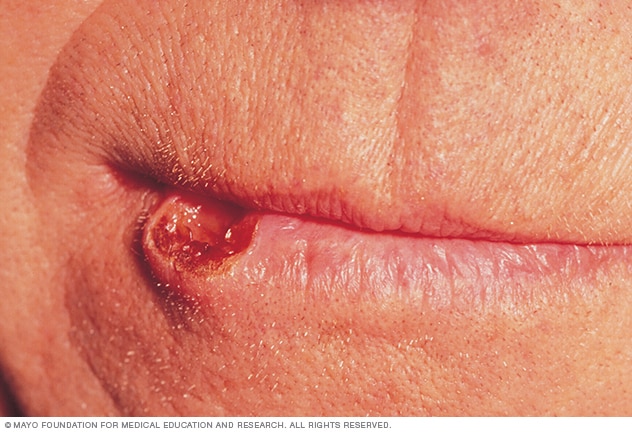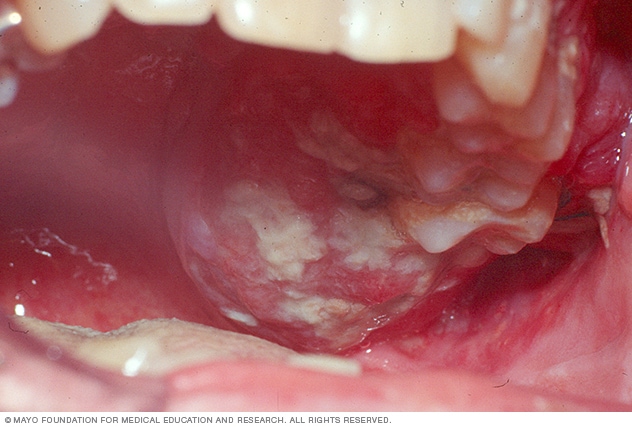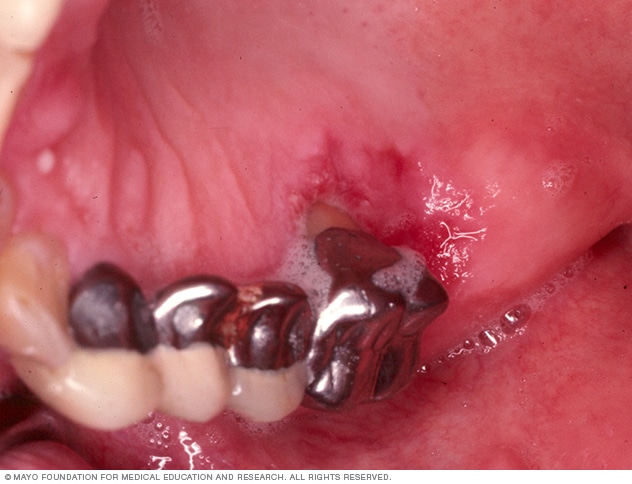Oral cancer
Oral cancer
overview
What is oral cancer? A Mayo Clinic expert explains
Learn more about oral cancer, also called mouth cancer, from oncologist Katharine Price, MD
View transcript
Hello, I'm Dr. Katharine Price, an oncologist at the Mayo Clinic. In this video we cover the basics of oral cancer: What is it? Who gets it? The symptoms, diagnosis and treatment. Whether you're looking for answers for yourself or someone you love, we're here to give you the best information available. Oral cancer, also called mouth cancer, forms in the oral cavity, which includes all the parts of your mouth that you can see when you open wide and look in the mirror. Your lips, gums, tongue, cheeks, roof of your mouth, or the floor of your mouth. Oral cancer occurs when cells on the lips or mouth mutate. Most often, they start in the flat, thin cells that line your lips and the inside of your mouth. These are called squamous cells. Small changes to the DNA of squamous cells cause the cells to grow abnormally. These mutated cells accumulate and form a tumor that grows in the mouth and often spreads to the lymph nodes in the throat. Oral cancer is curable if detected at an early stage. And as with other cancers, great efforts have been made to identify causes and improve treatments.
The average age of those diagnosed with oral cancer is 63 years. Just over 20% of cases occur in patients under 55 years of age. However, it can affect anyone. There are several known risk factors that may increase your risk of developing oral cancer. If you use tobacco, cigarettes, cigars, pipes, chewing tobacco, and others, you are at greater risk. Heavy alcohol consumption also increases the risk. People with HPV, the human papilloma virus, are at higher risk of also developing oral cancer. Other risk factors include a diet without fruit and vegetables, chronic irritation or inflammation in the mouth and a weakened immune system.
Oral cancer can show up in many different ways, including: a lip or mouth infection that doesn't heal, a white or reddish spot on the inside of your mouth, loose teeth, a growth or bump in the mouth, pain in the mouth, ear pain, and difficulty or pain when swallowing, opening your mouth, or chewing. If you experience any of these problems and persist for more than two weeks, see a doctor. You can first rule out more common causes, such as infection.
To determine whether you have oral cancer, your doctor or dentist will usually do a physical exam to check for irritations such as sores or white spots. If they suspect something is not normal, they may perform a biopsy, where they take a small sample of the area for testing. If oral cancer is diagnosed, your medical team will determine how advanced the cancer is or what stage the cancer is at. The stage of the cancer ranges from 0 to 4 and helps your doctor advise you on the likelihood of successful treatment. To determine the stage, they may perform an endoscopy, where doctors examine your throat with a small camera, or they may order imaging tests such as CT scans, PET scans, and MRIs to gather more information.
Your treatment plan will depend on the location and stage of your cancer, as well as your health and personal preferences. You may only have one type of treatment, or you may need a combination of cancer treatments. Surgery is the main treatment for oral cancer. Surgery generally means removing the tumor and possibly the lymph nodes in the neck. If the tumor is large, reconstruction may be necessary. If the tumor is small and there is no evidence of spread to the lymph nodes, surgery alone may be sufficient treatment. If the oral cancer has spread to lymph nodes in the neck or is large and invades different areas of the mouth, further treatment is necessary after surgery. This could include radiation, which uses high-energy beams of energy to attack and destroy the mutated cancer cells. Sometimes chemotherapy is combined with radiation. Chemotherapy is a powerful cocktail of chemicals that kills cancer. Immunotherapy, a newer treatment that helps your immune system attack the cancer, is also sometimes used.
Learning that you have oral cancer can be difficult. It can leave you feeling helpless. But remember that information is power when it comes to your health. This disease is survivable – now more than ever. Be informed. Take control of your health. And work with your medical team to find a treatment that's right for you. If you would like to learn more about oral cancer, check out our other related videos or visit mayoclinic.org. We wish you all the best.
Lip cancer

Lip cancer
Lip cancer can appear as a sore on your lip that doesn't heal.
Oral cancer – white spots

Oral cancer – white spots
Signs of oral cancer may include bleeding, swelling, white patches, or redness in the mouth.
Oral cancer – red sore

Oral cancer – red sore
Signs of mouth cancer can include red sores that don't heal.
Oral cancer refers to cancer that develops in any of the parts that make up the mouth (oral cavity). Oral cancer can occur in:
- Lippen
- Zahnfleisch
- Zunge
- Innenfutter der Wangen
- Gaumen
- Mundboden (unter der Zunge)
Cancer that occurs on the inside of the mouth is sometimes called oral cancer or oral cancer.
Oral cancer is one of several types of cancer grouped into a category called head and neck cancer. Oral cancer and other head and neck cancers are often treated similarly.
Symptoms
Signs and symptoms of oral cancer may include:
- Eine Lippen- oder Mundwunde, die nicht heilt
- Ein weißer oder rötlicher Fleck auf der Innenseite Ihres Mundes
- Zähne verlieren
- Ein Wachstum oder Klumpen in Ihrem Mund
- Schmerzen im Mund
- Ohrenschmerzen
- Schwieriges oder schmerzhaftes Schlucken
When to go to the doctor?
Make an appointment with your doctor or dentist if you have persistent signs and symptoms that bother you and last longer than two weeks. Your doctor will likely first evaluate other more common causes of your signs and symptoms, such as: B. an infection.
Causes
Oral cancer occurs when cells on the lips or mouth develop changes (mutations) in their DNA. A cell's DNA contains the instructions that tell a cell what to do. The mutational changes tell the cells to continue growing and dividing when healthy cells would die. The abnormal oral cancer cells that accumulate can form a tumor. Over time, they can spread into the mouth and to other areas of the head and neck or other parts of the body.
Oral cancer most often begins in the flat, thin cells (squamous cells) that line your lips and the inside of your mouth. Most oral cancers are squamous cell carcinomas.
It's not clear what causes the mutations in squamous cells that lead to oral cancer. However, doctors have identified factors that may increase the risk of oral cancer.
Risk factors
Factors that may increase your risk of oral cancer include:
- Tabakkonsum jeglicher Art, einschließlich unter anderem Zigaretten, Zigarren, Pfeifen, Kau- und Schnupftabak
- Starker Alkoholkonsum
- Übermäßige Sonneneinstrahlung auf Ihre Lippen
- Ein sexuell übertragbares Virus namens humanes Papillomavirus (HPV)
- Ein geschwächtes Immunsystem
prevention
There is no proven way to prevent oral cancer. However, you can reduce your risk of oral cancer if you:
- Hören Sie auf zu rauchen oder fangen Sie nicht an. Wenn Sie Tabak konsumieren, hören Sie auf. Wenn Sie keinen Tabak verwenden, fangen Sie nicht an. Die Verwendung von Tabak, ob geraucht oder gekaut, setzt die Zellen in Ihrem Mund gefährlichen krebserregenden Chemikalien aus.
- Trinken Sie Alkohol nur in Maßen, wenn überhaupt. Chronischer übermäßiger Alkoholkonsum kann die Zellen in Ihrem Mund reizen und sie anfällig für Mundkrebs machen. Wenn Sie sich entscheiden, Alkohol zu trinken, tun Sie dies in Maßen. Für gesunde Erwachsene bedeutet dies bis zu einem Drink pro Tag für Frauen jeden Alters und Männer über 65 Jahren und bis zu zwei Drinks pro Tag für Männer im Alter von 65 Jahren und jünger.
- Vermeiden Sie übermäßige Sonneneinstrahlung auf Ihre Lippen. Schützen Sie die Haut Ihrer Lippen vor der Sonne, indem Sie sich möglichst im Schatten aufhalten. Tragen Sie einen breitkrempigen Hut, der Ihr gesamtes Gesicht, einschließlich Ihres Mundes, effektiv beschattet. Tragen Sie als Teil Ihres routinemäßigen Sonnenschutzprogramms ein Sonnenschutz-Lippenprodukt auf.
- Gehen Sie regelmäßig zu Ihrem Zahnarzt. Bitten Sie Ihren Zahnarzt im Rahmen einer routinemäßigen zahnärztlichen Untersuchung, Ihren gesamten Mund auf abnormale Bereiche zu untersuchen, die auf Mundkrebs oder präkanzeröse Veränderungen hinweisen können.
Oral cancer treatment
Sources:
- Flint PW, et al. Bösartige Neubildungen der Mundhöhle. In: Cummings HNO-Heilkunde: Kopf- und Halschirurgie. 6. Aufl. Philadelphia, Pennsylvania: Saunders Elsevier; 2015. https://www.clinicalkey.com. Abgerufen am 28. November 2018.
- Kopf-Hals-Krebs. Plymouth Meeting, Pa.: Nationales umfassendes Krebsnetzwerk. http://www.nccn.org/professionals/physician_gls/f_guidelines.asp. Abgerufen am 28. November 2018.
- Fragen Sie MayoExpert. Kopf-Hals-Krebs. Rochester, Minnesota: Mayo Foundation for Medical Education and Research; 2017.
- Behandlung von Lippen- und Mundhöhlenkrebs (PDQ). Nationales Krebs Institut. https://www.cancer.gov/types/head-and-neck/patient/adult/lip-mouth-treatment-pdq. Abgerufen am 28. November 2018.
- Die mündliche Krebsuntersuchung. Nationales Institut für zahnärztliche und kraniofaziale Forschung. https://www.nidcr.nih.gov/sites/default/files/2018-10/oral-cancer-exam.pdf. Abgerufen am 28. November 2018.
- Krebsbedingte Müdigkeit. Plymouth Meeting, Pa.: Nationales umfassendes Krebsnetzwerk. http://www.nccn.org/professionals/physician_gls/f_guidelines.asp. Abgerufen am 28. November 2018.
- Erbitux (Verschreibungsinformationen). Branchburg, NJ: Eli Lilly and Company; 2018. http://www.erbitux.com. Abgerufen am 28. November 2018.
- Warner KJ. Allscripts EPSi. Mayo Clinic, Rochester, Minnesota, 18. Juli 2018.

 Suche
Suche
 Mein Konto
Mein Konto